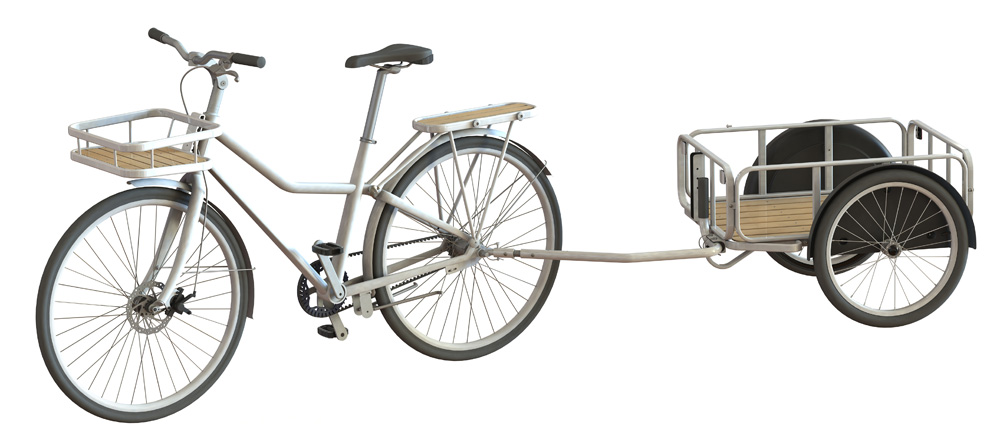TRANSPORT
The Sladda, IKEA's Lightweight Aluminium Bike
Sweden's IKEA was founded by 17-year-old Ingvar Kamprad in 1943. Since then, it has become a household name for furniture buyers across the planet.
12 May, 2016
What few of the customers that pack IKEA stores every weekend know, however, is that the company has ambitions beyond furniture and is expanding into the transportation market: specifically, by introducing their first flat-packed bicycle.
Countless houses, apartments, and student dorms the world over feature IKEA's signature furnishings, accessories, rugs, and household items. Spending a Saturday afternoon assembling one of the brand's instantly recognizable flat-pack wardrobes or tables has become a right of passage when settling into any new home. Branching out beyond its furniture wheelhouse, IKEA is now bringing its time-honored approach to simplicity and reliability to a new product: a no-frills, robust bicycle.

Image credit: IKEA
The new self-assembly bike will be known as the "Sladda," which in Swedish signifies "skid" or "slide sideways." The Sladda, which will go on sale in August 2016, is constructed of lightweight aluminium and is being marketed as the perfect vehicle for low-maintenance urban transportation. Even though a bicycle might not be an obvious product for a furniture company to put on offer, the company maintains the Sladda is an obvious fit for their brand.
The Sladda is the result of a partnership between IKEA and Swedish design studio Veryday, which has focused on "user-centric solutions" since 1969. Their director of industrial design, Oskar Juhlin, describes the Sladda as another example of this philosophy in action.
The Sladda is the result of a partnership between IKEA and Swedish design studio Veryday, which has focused on "user-centric solutions" since 1969. Their director of industrial design, Oskar Juhlin, describes the Sladda as another example of this philosophy in action.

Easy to maintain, practical and multi-gender urban transportation solution that supports a sustainable lifestyle.
Annique van der Valk, IKEA Commercial Press Officer

Sladda is like a tablet with apps in the sense that you can customise it with several different accessories adapted to make everyday life easier for the user.
Oskar Juhlin, Veryday Director of Industrial Design
These extra features could be anything from a bike bag to a trailer to tow behind the bicycle, allowing the Sladda to become a truly multi-purpose vehicle. Although supplied as a flat-pack for buyers to assemble at home the Sladda has been designed with ease of assembly in mind. Users will not require any technical knowledge to complete the bike assembly, which should take less than 30 minutes.

There are several features of the Sladda that make this new aluminium bike unique when compared with more traditional models. One of the most obvious is the lack of a traditional chain to drive the bike forward. In place of a steel chain that is prone is rust – especially when exposed to the elements – riders will find an oil-free and rust-free drive belt that can last about two to three times longer than a chain metal: 9,320 miles (15,000 kilometres), to be precise. The Sladda also lacks a conventional rear brake. Instead, pedalling backwards is how riders will stop the bike. This process that may take a while to get used to for anyone familiar with the conventional system of cable operated brakes. Automatic gears will be hidden at the rear wheel.
The lightweight, aluminium Sladda frame will be available in both 26-inch and 28-inch versions, and IKEA will sell it with a ten-year guarantee. The bike will also be supplied with an automatic gear-changing system designed by Bioshift, maximizing ease of use for all urban riders. The Sladda will retail for $797, although members of IKEA's loyalty program will be able to purchase it for $569 (for a limited time).
The lightweight, aluminium Sladda frame will be available in both 26-inch and 28-inch versions, and IKEA will sell it with a ten-year guarantee. The bike will also be supplied with an automatic gear-changing system designed by Bioshift, maximizing ease of use for all urban riders. The Sladda will retail for $797, although members of IKEA's loyalty program will be able to purchase it for $569 (for a limited time).
The Sladda is not Ikea's first attempt to capture urban riders. Back in 2014 they marketed an electric bike at a small number of their stores in Austria. At that time, the experiment was considered unsuccessful and was stopped after only a few months: it was suggested that the bikes were too expensive to be profitable for Ikea.
This new venture, however, appears to be on a much bigger scale than the previous experiment. According to Oskar Juhlin: "Sladda enables the user to replace the car and by doing so contributing to a more eco-friendly environment."
This new venture, however, appears to be on a much bigger scale than the previous experiment. According to Oskar Juhlin: "Sladda enables the user to replace the car and by doing so contributing to a more eco-friendly environment."
Banner image by Håkan Dahlström.